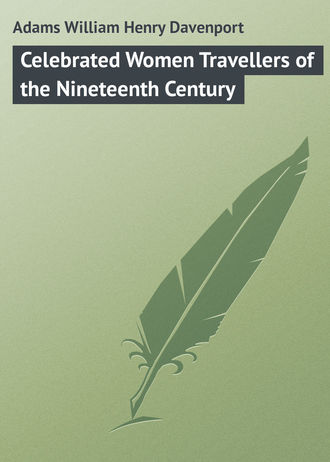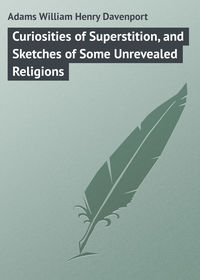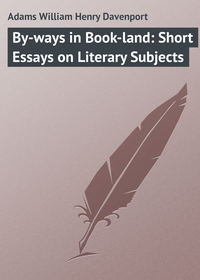 полная версия
полная версияCelebrated Women Travellers of the Nineteenth Century
On the 1st of March our adventurous traveller, having resolved on putting a girdle round about the world, took her passage for China in the Dutch barque Lootpuit, Captain Van Wyk Jurianse. On the 26th of April, her eyes were gladdened with a view of the "island-Eden" of the Southern seas, Tahiti, the largest and most beautiful of the Society group. From the days of Bougainville, its discoverer, down to those of "the Earl and the Doctor," who recently visited it, Tahiti has moved the admiration of voyagers by the charms of its scenery. It lifts the summit of its pyramidal mass out of a wealth of luxuriant vegetation, which sweeps down to the very margin of a sea as blue as the sky above it. Cool verdurous valleys slope gently into its mountain recesses, their swelling declivities loaded with groves of bread-fruit and cocoa-nut trees. The inhabitants, physically speaking, are not unworthy of their island-home; a tall, robust, and well-knit race, they would be comely but for their custom of flattening the nose as soon as the child is born. They have thick jet-black hair and fine dark eyes. The colour of their skin is a copper-brown. Both sexes, at the time of Ida Pfeiffer's visit, preserved the custom of tattooing, the devices being often very fanciful in design, and always artistically executed.
The Tahitian women have always been notorious for their immodesty; and notwithstanding the past labours of English missionaries, the island continues to be the Polynesian Paphos. The moral standard of the population has not been raised since they came under the shadow of a French protectorate.
Madame Pfeiffer undertook an excursion to the Lake Vaihiria, assuming for the occasion a kind of masculine attire, very suitable if not peculiarly becoming. She wore, she tells us, strong men's shoes, trousers, and a blouse, which covered the hips. Thus equipped, she started off with her guide, and in the first six miles waded through about two-and-thirty brooks. Then, through a maze of ravines, she struck off into the interior. As they advanced, she noticed that the fruit trees disappeared, and that instead the slopes were covered with plantains, tarros, and marantas, the last attaining a height of twelve feet, and growing so luxuriantly that it was with some difficulty the traveller made her way through the tangle. The tarro, or taro, which is carefully cultivated, averages two or three feet in height, and has fine large leaves and tubers like those of the potato, but not so good when roasted. Very graceful is the appearance of the plantain, or banana, which varies from twelve to fifteen feet in height, and has fine large leaves like those of the palm, but a brittle reedy stem, not more than eight inches in diameter. It attains its full growth in the first year, bears fruit in the second, and then dies; thus its life is as brief as it is useful.
Tahiti is an island of many waters; through one bright crystal mountain-stream, which swept along the ravine over a stony bed, breaking and dimpling into eddies and tiny whirlpools, and in some places attaining a depth of three feet, Madame Pfeiffer and her guide waded, or half swam, two-and-sixty times. We are filled with admiration at the resolute spirit of this courageous woman, who, though the track at every step became more difficult and dangerous, persisted in pressing forward. She clambered over rocks and stones; she forced her way through intertangled bushes; and, though severely wounded in hands and feet, never faltered for a moment. At two points the ravine narrowed so considerably that the entire area was filled by the brawling torrent.
In eight hours the bold traveller and her guide had walked, waded, and clambered some eighteen miles, and attained an elevation of fully eighteen hundred feet. The lake itself was not visible until they came upon its very margin, for it lies deep down in a dark hollow among lofty precipices, which, with startling abruptness, descend to the edge of the darkling waters. To cross the lake the traveller must trust to his swimming powers, or to a curiously frail kind of boat which the natives construct on the spot with equal skill and rapidity. Ida Pfeiffer was nothing if not adventurous, and whatever was to be dared, she straightway confronted. At her request, the guide turned boat-builder. He tore off some branches of plantain, bound them together with long tough grass, laid a few leaves upon them, launched them in the water, and then requested Madame Pfeiffer to embark. She acknowledges to have felt a little hesitation, but, without saying a word, stepped "on board." Her guide took to the water like a duck, and propelled the crazy craft, which, however, made the transit of the lake, and back again, without accident.
Having fully satisfied herself with admiring the lake and its surrounding scenery, she withdrew to a little nook thatched over with leaves, where her guide quickly kindled a good fire in the Indian fashion. Cutting a small piece of wood to a fine point, and then selecting a second piece, which he grooved with a narrow and not very deep furrow, in this he rubbed the pointed stick until the fragments detached during the process began to smoke. These he flung into a heap of grass and dry leaves previously collected, and swung the whole several times round in the air until it ignited. The entire operation did not occupy more than two minutes. Some roasted plantains served for supper; after which Madame Pfeiffer retired to her lonely couch of dry leaves, to sleep as best she might. Who will refuse a tribute of admiration to the courage, self-reliance, and intrepidity of this remarkable woman? Who but must admire her wonderful physical capabilities? How many of her sex could endure for a week the exposure and fatigue to which she subjected herself year after year?
The night passed without any eventful incident, and on the following morning she accomplished the return journey in safety.
On the 17th of May she left Tahiti, the Dutch vessel in which she had embarked being bound viâ the Philippines. This rich and radiant island group they passed on the 1st of July, and the next day entered the dangerous China Sea. Soon afterwards they reached Hong Kong, which had been an English settlement since 1842. But as Madame Pfeiffer wanted to see the Chinese at home, she made no stay in this hybrid town, but ascended the Pearl River, marvelling much at the immense rice-plantations on either bank, and the quaint little country houses, with their fronts of coloured tiles, to Canton. As she approached this great seat of commerce, she was much moved by the liveliness of the scene. The river was thronged with ships and inhabited boats – with junks almost as large as the old Spanish galleons, their poops impending far over the water, and covered in with a roof, like a house; with men-of-war, flat, broad, and long, mounted with twenty or thirty guns, and ornamented in the usual Chinese mode, with two large painted eyes at the prow, that they may be the better able to see their way. Mandarins' boats she saw, with doors, and sides, and windows gaily painted, with carved galleries, and tiny silken flags fluttering from every point. And flower-boats she also saw; their upper galleries decked with flowers, garlands, and arabesques, as if they were barks fitted out for the enjoyment of Queen Titania and her fairy company. The interior is divided into one large apartment and a few cabinets, which are lighted by quaint-patterned windows. Mirrors and silken hangings embellish the sides, while the enchanting scene is completed with a liberal store of glass chandeliers and coloured paper lanterns, interspersed with lovely little baskets of fresh flowers.
It was characteristic of Madame Pfeiffer that she found access to so much which no European woman had ever seen before. She obtained entrance even into a Buddhist temple – that of Honan, reputed to be one of the finest in China. A high wall surrounds the sacred enclosure. The visitor enters first a large outer court, and thence, through a huge gateway, passes into the inner. Beneath the gateway stand the statues of war-gods, each eighteen feet high, with faces terribly distorted, and in the most threatening attitudes; these are supposed to prevent the approach of evil genii. A second portal, similarly constructed, under which the "four heavenly kings" sit enthroned, leads to a third court, surrounding the principal sanctuary, which measures one hundred feet in length, and is of equal breadth. On rows of wooden pillars rests a flat roof, from which hang glass lamps, lustres, artificial flowers, and brightly-coloured ribbons. All about the area are scattered altars, statues, vases of flowers, censers, and candelabra.
But the eye is chiefly attracted by the three shrines in the foreground, with the three coloured statues behind them, of Buddha, seated as symbolical of Past, Present, and Future. On the occasion of Madame Ida Pfeiffer's visit, a funeral ceremony was being performed in honour of a mandarin's deceased wife. Before the right and left altars stood several priests, in garments curiously resembling, as did the rites also resemble, those of the Roman Church. The mandarin himself, attended by a couple of fan-bearers, prayed before the middle altar. He kissed the ground repeatedly, and each time he did so, thin, fragrant wax tapers were put into his hands. These, after raising in the air, he handed to the priests, who then stationed them, unlighted, before the Buddha images. Meantime, the temple resounded with the mingling strains of three musicians, one of whom struck a metal ball, while another scraped a stringed instrument, and a third educed shrill notes from a kind of flute.
This principal temple is surrounded by numerous smaller sanctuaries, each decorated with images of deities, rudely wrought, but a-glow with gold and vivid colours. Special reverence seems to be accorded to Kwanfootse, a demi-god of war, and to the four-and-twenty gods of mercy. These latter have four, six, and even eight arms. In the Temple of Mercy, Madame Pfeiffer met with an unpleasant adventure. A Bonze had offered her and her companions a couple of wax tapers to light in honour of the god. They were on the point of compliance, as a mere act of civility, when an American missionary, who was one of the visitors, roughly snatched them from their hands, and gave them back to the priests, protesting that such compliance was idolatrous. It was not without difficulty they forced their way through the crowd, and escaped from the temple.
The curiosity hunters were next led to the so-called House of the Sacred Swine. These porcine treasures are as tenderly cared for as was Hamlet's mother by Hamlet's father. They reside in a spacious hall of stone, but the atmosphere, it must be owned, teems with odours that are not Sabæan. Throughout their idle existence, the swine are reverentially cherished and liberally fed; nor is the cruel knife permitted to cut short the thread of their destiny. At the time of Ida Pfeiffer's visit, only one pair were living in this otiose state, and the number seldom exceeds three pairs.
From China our adventurous lady sailed for the East Indies, "looking in" on the way at Singapore, a British settlement, which forms the meeting-place of the traders of South Asia. The scenery around it is of a rich and agreeable character, and the island on which it is situated excels in fertility of vegetation. Very pleasant the visitor finds it, to saunter among the plantations of cloves and nutmegs, the air breathing a peculiar balsamic fragrance, a concentration of sweet odours. Pepper and gambie plantations are also among the sights of Singapore. Further, it is an island of fruits. Here thrives the delectable mangosteno, which almost melts in the mouth, and enchants the palate with its exquisite flavour. Here, too, the pine-apple frequently attains the weight of four pounds. Here grows the saucroys, as big as the biggest pine-apple, green outside, and white or pale yellow inside, with a taste and perfume like that of the strawberry. And to Singapore belongs the custard-apple, which is as savoury as its compound name implies.
From Singapore, Madame Pfeiffer crossed to Point de Galle, in Ceylon. The charming appearance of this island from the sea moved her, as it moves every traveller, to admiration. "It was one of the most magnificent sights I ever beheld," she says, "that island soaring gradually from the sea, with its mountain ranges growing more and more distinctly defined, their summits lighted by the sun, while the dense cocoa-groves, and the hills, and the plains lay shrouded in cool shadows." Above the whole towers the purple mass of Adam's Peak, and wherever the eye roams, it surveys the most prodigal foliage, and glades rich in verdure, and turfy slopes deep in flowers.
Point de Galle presents a curious mixture of races. Cingalese, Kanditores, Tamils from South India, and Moormans, with crimson caftans and shaven crowns, form the bulk of the crowd that throng its streets; but, besides these, there are Portuguese, Chinese, Jews, Arabs, Parsees, Malays, Dutchmen, English, with half-caste burghers, and now and then a veiled Arab woman, or a Veddah, one of the aboriginal inhabitants of the island. Sir Charles Dilke speaks of "silent crowds of tall and graceful girls, as we at first supposed, wearing white petticoats and bodices, their hair carried off the face with a decorated hoop, and caught at the back by a high tortoise-shell comb. As they drew near, moustaches began to show, and I saw that they were men, whilst walking with them were women naked to the waist, combless, and far more rough and 'manly' than their husbands. Petticoats and chignons are male institutions in Ceylon."
With indefatigable energy of mind and body, Madame Pfeiffer visited Colombo and Kandy, the chief towns of the island. At the latter she obtained admission to the temple of Dagoba, which contains a precious relic of Buddha, namely, one of his teeth. The sanctuary enshrining it is a small chamber or cell, less than twenty feet in breadth. It is shrouded in darkness, for of windows there are none, and the door is curtained inside, still more effectually to exclude the light. Rich tapestry covers the walls and ceiling. But the principal object is the altar, which glitters with plates of silver, and is encrusted about the edges with precious stones. Upon it rests a bell-shaped case, about three feet high, and at the base three feet in diameter. It is made of silver, is elaborately gilt, and decorated with costly jewels. In the middle blazes a peacock of precious stones. Six smaller cases, said to be of gold, each diminishing in size, are enclosed within the large case, and under the last is the tooth of Buddha. It is as large as that of a great bull, so the great Indian philosopher must have had a monstrous jaw!
Madame Pfeiffer arrived at Madras on the 30th of October. Thence she proceeded to Calcutta, the city of palaces; but, of course, she adds nothing to the information furnished by a swarm of travellers. She saw the broad flood of the Ganges, and, filling a glass with its sacred water, drank to the health of the Europeans and all whom she loved.
Throughout her Indian travel she felt much vexed at being conveyed in a palanquin; it seemed a dishonouring of men to treat them as beasts of burden. However, necessity prevailed over her humanitarian scruples. Unlike the majority of Indian tourists, she went everywhere without an expensive retinue of attendants; she had but one servant, yet she contrived to go everywhere, and to see all that was to be seen. It is worth noting that she reduced the cost of travel to a minimum, and accomplished the circuit of the globe for a less sum than the rent of a furnished house in Mayfair for only a twelvemonth. It is true that she submitted to privations which the English tourist would deem insupportable; she embarked in sailing ships because they were cheaper than steamers; resorted to third-class railway carriages; avoided expensive hotels; lived always with the "masses" and on plainest fare; and dispensed with the services of dragoman or interpreter. But for all that her enjoyment was not the less, and she saw much which, had she travelled in the usual fashion, she would not have seen.
One is apt to think that a woman who accomplished such really remarkable feats of endurance and energy must have been endowed with great physical strength and robust proportions. But such was by no means the case. Her stature did not exceed – nay, was below – the average, and there was nothing masculine in her face or figure. "I smile," she says in one of her letters, "when I think of those who, knowing me only through my voyages, imagine that I must be more like a man than a woman! Those who expect to see me about six feet high, of bold demeanour, and with pistol in my belt, will find me a woman as peaceable and as reserved as most of those who have never set foot outside their native village."
At Benares she saw the bazaars, and the temples, and the palaces; the bathing in the Ganges, the burning of the dead on the bank of the sacred river, and a nautchni or dance of nautches; but her attention was chiefly drawn to the miserable fanaticism of the fakeers, who revelled in self-imposed tortures. Thus they stuck an iron hook through the flesh, and allowed themselves to be suspended by it at a height of twenty or twenty-five feet; or for long hours they stood upon one foot in the burning sunshine, with their arms rigidly extended in the air; or they held heavy weights in various positions, swinging round and round for hours together, and tearing the flesh from their bodies with red-hot pincers. One man held a heavy axe over his head as if about to fell a tree, and in this position stood immovable like a statue; another held the point of his toe to his nose. Yet, from one point of view, these men are right. What torture of the body can equal the torture of the soul? If it were possible by any amount of physical pain to still and silence the agony of conscience, who would not endure it? The greatest condemnation of the self-cruelty of the fakeers is – its uselessness.
In her tour through India Madame Pfeiffer visited Allahabad, at the junction of the Jumna and the Ganges; Agra, where she surveyed with admiring eyes the lovely Taj-Mahal, erected by the Sultan Jehan as a memorial to his favourite wife, and the Pearl Mosque, renowned for the beauty of its carving; Delhi, the ancient capital of the Moguls; the cave-temples of Ellora and Ajunta, and the great commercial port of Bombay.
Crossing the border of British India, she sailed to Bassora, and ascended the historic Tigris – so named from the tiger-like swiftness of its course – to Bagdad, that quaint Oriental city, which is associated with so many wonderful legends and not less wonderful "travellers' tales." This was of old the residence of the great Haroun-al-Raschid, a ruler of no ordinary sagacity and the hero of many a picturesque tradition, whose name the "Thousand and One Nights" have made familiar to every English reader. It is still a populous and wealthy city, with, we suspect, a future before it not less glorious than its past. Many of its houses are surrounded by blooming gardens; its shops are bright with the products of Eastern looms; and it descends in terraces to the river banks, which are lined with orchards and groves of palm. Over all extends the arch of a glowing sky.
From Bagdad Madame Pfeiffer made an excursion to the ruins of Babylon. They consist of massive fragments of walls and columns, lying on either side of the Euphrates.
On the 17th of June she joined a caravan which was bound for Mosul, a journey of three hundred miles, occupying from twelve to fourteen days, and lying across a desert country of the most inhospitable character. Madame Pfeiffer's experiences on this journey were new and interesting. One day she repaired to a small village in search of food. After wandering from hut to hut, she obtained a small quantity of milk and three eggs. These she laid in hot ashes, covering them completely; filled her leathern flask from the Tigris, and thus provided regained the encampment formed by the caravan. She ate her eggs and drank her milk with an appetite, which, to an epicure, would have been a surprise.
The manufacture of butter at this village was conducted on primitive principles. The cream was poured into a leathern bottle, and rolled about on the ground until consolidated into butter, which was then transferred to a bottle filled with water, and eventually turned out as white as snow.
Next day, when they rested during the heat, the guide of the caravan endeavoured to procure her a little shelter from the sun's pitiless glare by laying a small cover over a couple of poles let into the ground; but so small was the area thus protected, and so weak the artificial tent, that she was compelled to sit immovably in one position, as the slightest motion would have overthrown it. Shortly afterwards, when she wished to dine, she could obtain nothing but lukewarm water, bread so hard that she was obliged to soak it before it was eatable, and a cucumber without salt or vinegar.
At a village near Kerku the caravan halted for ten days. On the first day Madame Pfeiffer's patience was severely tested; for all the women of the place hastened to examine "the strange woman." First they inspected her clothes, and next wanted to take off her turban; in fact, they were inquisitive beyond all toleration. At last, Madame Pfeiffer seized one of them by the arm, and turned her out of her room with so much promptitude that she had no time to think of resistance. By the eloquence of gesture, our traveller made the others understand that, unless they withdrew at once, a similarly abrupt dismissal awaited them. She then drew a circle round her place, and forbade them to cross it; a prohibition which was strictly respected.
She had next to settle with the wife of her guide, who had besieged her the whole day, and incessantly petitioned for largesse. Fortunately her husband came on the scene, and to him Madame Pfeiffer preferred her complaint, threatening to leave his house and seek shelter elsewhere, well knowing that the Arabs consider this a great disgrace. He immediately ordered his wife to desist, and the traveller was at peace. "I always succeeded," says Madame Pfeiffer, "in obtaining my own will. I found that energy and boldness influence all people, whether Arabs, Persians, Bedouins, or others." It was this strength of will which crowned Madame Pfeiffer's enterprises with success.
Towards evening, she says, she saw, to her great delight, a caldron of mutton seething on the fire. For eight days she had eaten nothing but bread, cucumber, and a few dates; she had a great craving, therefore, for a hot and more nutritious meal. But her appetite declined when the style of cookery was forced on her notice. The old woman, her guide's mother, threw several handfuls of small grain and a large quantity of onions into a pan full of water to soften. In about half an hour she thrust her dirty hands into the water, and mixed the whole together, now and then taking a mouthful, and, after chewing it, spitting it back again into the pan! She then took a dirty rag, strained off the juice, and poured it over the flesh in the caldron. Madame Pfeiffer had firmly resolved to refuse the dish, but when it was ready her appetite was so keen, and the smell so savoury, that her resolution gave way, and she comforted herself with the reflection that she must often have eaten of food prepared in a similar manner. What we do not see, it is easy enough to tolerate.
On the 28th of June the caravan reached Erbil, anciently Arbela, the scene of one of Alexander the Great's most famous victories. Two days later they crossed the great river Sab upon rafts of inflated skins, fastened together with poles, and covered with reeds, canes, and planks. Rapidly traversing the Mesopotamian wastes, they arrived at Mosul on the 1st of July, and thence Madame Pfeiffer proceeded to inspect the ruins of Nineveh. Her description of them, however, presents no points of interest to merit quotation.
A caravan being about to start for Tabrîz, Madame Ida Pfeiffer decided that she would join it, though warned that it would traverse a country containing not a single European. But, as we have seen, she was a woman who knew not what fear was. Nothing could divert her from a fixed purpose. She had made up her mind to go to Persia, and to Persia she would go. The caravan set out on the 8th of July, and next day crossed the hills that intervene between Mesopotamia and Kurdistan. The latter country has never enjoyed a good reputation among travellers, and Madame Pfeiffer's experience of it confirmed its evil fame. The travellers were crossing a recently reaped corn-field, when half-a-dozen Kurds, armed with stout cudgels, sprang out from their hiding-place among the sheaves, and, seizing the bridles, poured out a volley of mingled oaths and menaces. One of the travellers leaped from his steed, seized his assailant by the throat, and, holding to his head a loaded pistol, indicated his determination to blow out his brains. The effect of this courageous conduct was immediate; the robbers desisted from their attack, and were soon engaged in quite a friendly conversation with those whom they had intended to plunder. At last they pointed out a good site for an encampment, receiving in return a trifling backshish, collected from the whole caravan.







